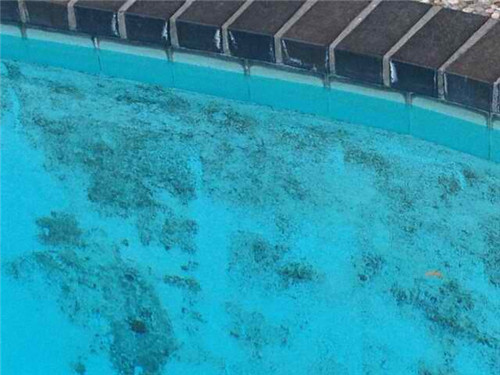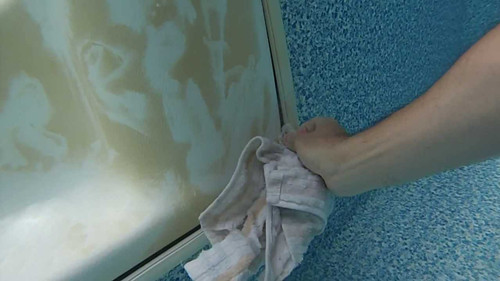Isn’t it usual when you pull back the liner, black and floccus splotches spread behind it like disgusting feces? It’s not a joke. Those sticky thing isn’t mere algae. It’s something far more beyond your imagination: mold, fungus, bacteria and virus. They can cause pool owners and pool cleaning specialists no end of torment. Here, BluwhaleTile provides you some insights about how to conquer pool stains the instant they start to take shape.
Thoroughly Know about the Stains
Once micro-organisms start colonizing behind the liner and left unchecked over a period, ultimately that will penetrate into the printed side, appearing as greenish black as the mildew spots. To prevent this situation, many liner producers add biocides into the makeup of vinyl, but it seems not a permanent solution.
This kind of stain is often misrecognised as algae and many pool owners will treat it in a wrong way, that is, overusing chlorine additives, which will cause a sudden drop in pH. Some will even dive down to scratch off the stains with a chlorine tab inside a sponge. The stains will fade to some extent, but don’t expect it as a root-out solution because they will return once chlorine level goes down. Sometime this is the only way to know for sure that something is flourishing behind the liner. At other times, the surrounding environment will give hint that something is getting worse under water. For example, the sudden overgrowth of some marsh-thriving plants, like skunk cabbage, can be seen as a clue. The stains are usually found on the deep bottom while in extreme cases, they may crawl up the walls.

Effectively Tackle the Stains
When faced with this reality, it’s always better to take action as early as possible. There are some options you can adopt and try them on.
Some pool maintenance specialists claim that the most efficient defense against the spreading stains is to insert a barrier between the liner and the ground. And it’s especially applicable to vermiculite bottom. Though the liner has a protective coating against the creeping stains, as a double insurance you may want to shovel off the most infected parts and mend the cracks and holes with new materials.
1. Give the shell enough time to dry, scrub off any dirt and repair all broken parts before applying the latex coating.
2. Fill up the entire surface with barriers.
3. Allow no less than 24 hours to dry the shell before liner replacement.
There is another approach keeping stains in their place. Place a polyethylene/plastic sheet behind the liner to constrain micro-organisms, bacteria and algae from spreading to the surface. However, it’s not a flawless solution: if the liner floats, the sheet could wrinkle.
In less severe cases, a little bleach might be alright to get thing done. 1. Peel off the stains with a brush when the shell gets dry. 2. Dip the floor and the walls with the mixture of water and bleach. 3. Repeat this several times according to the removal performance. And make sure the mixture is put on the bottom of the liner as well.

Vinyl Liner vs. Border Tile
After hearing these treatment options, I bet many of you will also want to know if the existent liner must be replaced. That, without doubt, relies upon its condition. Sometimes the liner is savable if it looks relatively new after treatment. If you didn’t install the liner extremely tight at the beginning, it can be reset, but that’s not always a possibility. If you can’t bear any aging part, then replace the liner with a more darker pattern because stains can blend in it to the largest extent when the blemish returns.
In fact, you could have never encountered those problems if applying border tile in your pool at the beginning. Glass border tiles and ceramic border tiles are the two most popular options. It’s time saving to clean them rather than use different methods you can think of to prolong the lifespan of the vinyl liner, which is not durable in the moist and wet place. Once stains start to spread, it’s both convenient to clean them by drain or no-drain approach. Some pool owners suspect there is limited pattern options for border tile. Instead, many pool tile suppliers have been seasonally launching border tiles with innovative patterns to meet the market demand. There’s no need to worry that you can’t find your favor.

BluwhaleTile supplies you a great variety of pool tile that are made of ceramic, porcelain, glass, mosaic, natural stone, etc. Welcome to visit us at http://www.bluwhaletile.com/ for more pool tile design options.